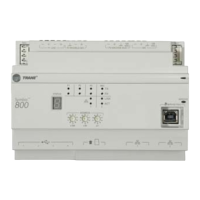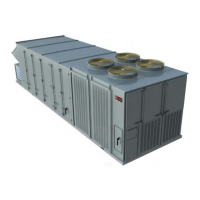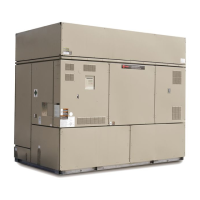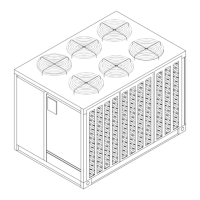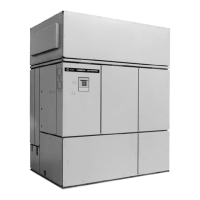RT-SVX24Q-EN
197
Refrigeration System
WWAARRNNIINNGG
RR--441100AA RReeffrriiggeerraanntt uunnddeerr HHiigghheerr
PPrreessssuurree tthhaann RR--2222!!
FFaaiilluurree ttoo uussee pprrooppeerr eeqquuiippmmeenntt oorr ccoommppoonneennttss aass
ddeessccrriibbeedd bbeellooww,, ccoouulldd rreessuulltt iinn eeqquuiippmmeenntt ffaaiilliinngg
aanndd ppoossssiibbllyy eexxppllooddiinngg,, wwhhiicchh ccoouulldd rreessuulltt iinn
ddeeaatthh,, sseerriioouuss iinnjjuurryy,, oorr eeqquuiippmmeenntt ddaammaaggee..
TThhee uunniittss ddeessccrriibbeedd iinn tthhiiss mmaannuuaall uussee RR--441100AA
rreeffrriiggeerraanntt wwhhiicchh ooppeerraatteess aatt hhiigghheerr pprreessssuurreess
tthhaann RR--2222.. UUssee OONNLLYY RR--441100AA rraatteedd sseerrvviiccee
eeqquuiippmmeenntt oorr ccoommppoonneennttss wwiitthh tthheessee uunniittss.. FFoorr
ssppeecciiffiicc hhaannddlliinngg ccoonncceerrnnss wwiitthh RR--441100AA,, pplleeaassee
ccoonnttaacctt yyoouurr llooccaall TTrraannee rreepprreesseennttaattiivvee..
WWAARRNNIINNGG
RReeffrriiggeerraanntt uunnddeerr HHiigghh PPrreessssuurree!!
FFaaiilluurree ttoo ffoollllooww iinnssttrruuccttiioonnss bbeellooww ccoouulldd rreessuulltt iinn
aann eexxpplloossiioonn wwhhiicchh ccoouulldd rreessuulltt iinn ddeeaatthh oorr
sseerriioouuss iinnjjuurryy oorr eeqquuiippmmeenntt ddaammaaggee..
SSyysstteemm ccoonnttaaiinnss rreeffrriiggeerraanntt uunnddeerr hhiigghh pprreessssuurree..
RReeccoovveerr rreeffrriiggeerraanntt ttoo rreelliieevvee pprreessssuurree bbeeffoorree
ooppeenniinngg tthhee ssyysstteemm.. SSeeee uunniitt nnaammeeppllaattee ffoorr
rreeffrriiggeerraanntt ttyyppee.. DDoo nnoott uussee nnoonn--aapppprroovveedd
rreeffrriiggeerraannttss,, rreeffrriiggeerraanntt ssuubbssttiittuutteess,, oorr rreeffrriiggeerraanntt
aaddddiittiivveess..
Refrigerant Evacuation and Charging
NNOOTTIICCEE
CCoommpprreessssoorr DDaammaaggee!!
FFaaiilluurree ttoo ffoollllooww iinnssttrruuccttiioonnss bbeellooww rreessuulltt iinn
ppeerrmmaanneenntt ddaammaaggee ttoo tthhee ccoommpprreessssoorr..
TThhee uunniitt iiss ffuullllyy cchhaarrggeedd wwiitthh RR--441100AA rreeffrriiggeerraanntt
ffrroomm tthhee ffaaccttoorryy.. HHoowweevveerr,, iiff iitt bbeeccoommeess nneecceessssaarryy
ttoo rreemmoovvee oorr rreecchhaarrggee tthhee ssyysstteemm wwiitthh rreeffrriiggeerraanntt,,
iitt iiss iimmppoorrttaanntt tthhaatt tthhee ffoolllloowwiinngg aaccttiioonnss aarree ttaakkeenn..
The recommended method for evacuation and
dehydration is to evacuate both the high side and the
low side to 500 microns or less. To establish that the
unit is leak-free, use a standing vacuum test. The
maximum allowable rise over a 15 minute period is 200
microns. If the rise exceeds this, there is either still
moisture in the system or a leak is present.
IImmppoorrttaanntt:: Do Not release refrigerant to the
atmosphere! If adding or removing
refrigerant is required, the service
technician must comply with all federal,
state, and local laws.
• To prevent cross contamination of
refrigerants and oils, use only dedicated
R-410A service equipment.
• Disconnect unit power before
evacuation and do not apply voltage to
compressor while under vacuum.
Failure to follow these instructions will
result in compressor failure.
• Due to the presence of POE oil,
minimize system open time. Do not
exceed 1 hour.
• When recharging R-410A refrigerant, it
should be charged in the liquid state.
• The compressor should be off when the
initial refrigerant recharge is performed.
• Charging to the liquid line is required
prior to starting the compressor to
minimize the potential damage to the
compressor due to refrigerant in the
compressor oil sump at startup.
• If suction line charging is needed to
complete the charging process, only do
so with the compressor operating. Do
not charge liquid refrigerant into the
suction line with the compressor off!
This increases both the probability that
the compressor will start with
refrigerant in the compressor oil sump
and the potential for compressor
damage.
• Allow the crankcase heater to operate a
minimum of 8 hours before starting the
unit.
Charge Storage
Due to the reduced capacity of the microchannel
condenser coil compared to the round tube plate fin
evaporator coil, pumping refrigerant into the
condenser coil to service the refrigerant system is no
longer an option.
Compressor Oil
Refer to Table 75, p. 199 for the appropriate scroll
compressor oil charge. Remove and measure oil from
any compressor replaced. Adjust oil in replacement
compressor to prevent excessive oil in system.
Anytime a compressor is replaced, the oil for each
compressor within the manifold must be replaced.
The scroll compressor uses Trane OIL00079 (one quart
container) or OIL00080 (one gallon container) without
substitution. Discoloration of the oil indicates that an
abnormal condition has occurred. If the oil is dark and
SSeerrvviiccee aanndd MMaaiinntteennaannccee
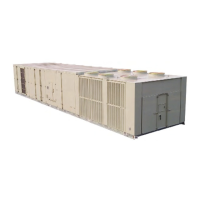
